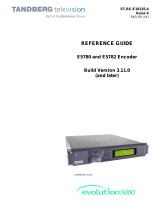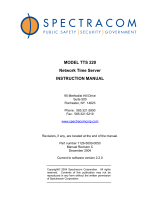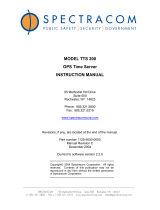Page is loading ...

800050-02 Rev. A Page 1 of 8 April 4, 2004
DTV744 Installation Quick Start Guide
The Wegener Model DTV744 8VSB 4-Channel Demodulator receives VHF/UHF broadcast HDTV 8VSB signals and provides output
ASI streams for connection to an advanced cable channel groomer. This guide provides information for setting up and operating the
DTV744. Additional information may be found on the Wegener web site at www.wegener.com/ (click the Customer Service tab and
follow instructions to access the DTV744 User’s Manual).
In addition to this guide, your box should include:
1. DTV744 8VSB 4-Channel Demodulator
2. Power cord 3. UL safety sheet
Front and Rear Panel Views
Connector/Pin-out/LED Information
Rear-Panel Connector Descriptions
Ref
Connector
Designation Type Signal Name Description
1 RF In 1, 2, 3, & 4 Type F RF IN 1, RF IN 2, RF IN 3, & RF IN 4 From VHF/UHF Antenna
2 ASI Out 1, 2, 3, & 4 BNC ASI OUT 1, ASI OUT 2, ASI OUT 3,
& ASI Out 2
To Advanced Cable Channel
Groomer, DTV700, or ASI Mux
3 Ethernet RJ-45 jack Ethernet_In & Out To LAN – for Web Interface
Control
4 Terminal DB-9 female RxD (output) & TxD (input) To Local Terminal
5 Relays DB-9 female Alarm, Warning, & Contact Closures To Alarm Monitoring
6 115/230 VAC IEC receptacle AC Line In To AC Power Outlet
Status Relays Signals(Ref 4) LED Indicator Descriptions
Pin # Function LED Description LED Description
9 Close on Alarm
4Alarm COM RF 1 ON – Tracking carrier
OFF – No carrier RF 2 ON – Tracking carrier
OFF – No carrier
8 Close on Warning
3 Warning COM RF 3 ON - Tracking carrier
OFF – No carrier RF 4 ON – Tracking carrier
OFF – No carrier
6 Open on Warning
1 Not used
7 Open on Alarm
WARNING
ON – See LCD / web
browser for details
OFF – No Warnings
ASI OUT
LOCK
ON – ASI output active
OFF – No ASI output
2 Not used
ALARM
ON – See LCD / web
browser for details
OFF – No alarms
LAN
ACTIVITY
BLINKS – parameter is being
changed via browser or SNMP
Program and PSIP Processing
The unit tunes and demodulates ATSC broadcast signals which are converted to ASI output Transport Streams.
All program and PSIP data received are passed through unchanged to the output ASI ports.
125
4 6
3

800050-02 Rev. A Page 2 of 8 April 4, 2004
Basic System Setup Diagram
Front-panel User Interface
Note that from any screen, pressing the ESC key twice will return you to the Home Screen.
Main-level Screens Second-level Screens
Home Screen (rotates through data from each of the four RF
inputs)
The channel number, modulation type (8VSB, 64QAM, or
256QAM), signal-to-noise ratio, and errored seconds are
displayed for each input.
Press the
key (if displayed) to go to Alarms/Warnings.
Press the ENT key to view the second-level Serial Number
and Application Software Version Number screen.
Serial Number and Application Software Version Number
Screen
Where XXXXXX is the unit's six-digit serial number and YYY is
the version number of the unit's currently installed application
software.
Press the ESC key to go to the Home Screen.
Alarms/Warnings
Press the ENT key to view any active alarms or warnings on
the second-level Alarms/Warnings Message screen.
Press the
key to go to Clear Errored Seconds (if counter is
non-zero) or Program Setup.
Press the ESC key to go to the Home Screen.
2nd-level Alarms/Warnings Message Screen
Any active alarms or warnings are described here.
Press the
key to view the next alarm or warning (if more than
one).
Press the ESC key to return to the Alarms/Warnings screen.
Clear Errored Seconds
This screen only appears if the errored seconds counter is
non-zero. Otherwise the next screen, Program Setup is
displayed.
Press the ENT to clear the errored seconds counter.
Press the
key to go to the Input Setup screen.
Press the
key to go to Alarms/Warnings.
Press the ESC key to go to the Home Screen.
RF3 CHAN:20 8VSB
SNR21.5 ErrSec:0002
View Alarms/Warnings
Clear Errored Secs
Press<ENT>
S/N:XXXXXX
V
ER:YYY
No Alarms or Warnings

800050-02 Rev. A Page 3 of 8 April 4, 2004
Main-level Screens Second-/Third-level Screens
2nd-level RF Input
Where X is the RF port number.
Press ENT to go to the third-level Input Setup Screens below and
use the
or
keys to select <ON> or <OFF>, adding or
removing this program to/from the output stream. Press ENT
again to confirm.
Press the
key to go to the next RF Input screen (1 through 4).
Press the ESC key to return to the Input Setup screen.
3rd-level Tuner Enable
Press the ENT key to toggle between ON and OFF, enabling or
disabling the tuner.
Press the
key to go to the Channel Number Selection screen.
Press the ESC key to return to the second-level RF Input screen.
3rd-level Channel Number Selection
Where XX is the current channel number.
Press ENT to enter the edit mode and use the
or
keys to
change the channel number. Press ENT again to confirm your
selection or ESC to cancel changes.
Press the
key to go to the RF Standard screen.
Press the
key to go to the Tuner Enable screen.
Press the ESC key to return to the second-level RF Input screen.
Input Setup
Press the ENT key to bring up the second-level Program
Input screen.
Press the
key to go to Program Status.
Press the
key to go to Clear Errored Seconds (if counter is
non-zero) or Alarms/Warnings.
Press the ESC key to go to the Home Screen.
3rd-level RF Standard
Press ENT and use the
or
keys to toggle the RF Standard
between Broadcast and Cable. Press ENT again to confirm your
selection or ESC to cancel changes.
Press the
key to go to the Channel Selection screen.
Press the ESC key to return to the second-level RF Input screen.
Input Setup... RF Input X
Tuner Enable:
ON
Channel Number: XX
RF Standard:
Broadcast

800050-02 Rev. A Page 4 of 8 April 4, 2004
Main-level Screens Second-/Third-level Screens
2nd -level Program Status
where X is the input port number.
Press the ENT key to go to the third-level program status screen.
Press the
key to go to the next input (1 through 4).
Press the ESC key to return to the main-level Program Status
screen.
Program Status
Press the ENT key to view the second-level program status
screens.
Press the
key to go to Panel Help Timeout.
Press the
key to go to Program Setup.
Press the ESC key to go to the Home Screen.
3rd-level Program Status
where XXXXX is the program number at input, AAAAAAA is the
service descriptor for the program, Y is the ASI output port, and
BBBBBBB is the available audio on the input for the program (AC-
3, MPEG, or MPG/AC3).
Press the ESC key to return to the 2nd-level Program Status screen.
IP Address Selection
Press the ENT key and then press the arrow keys to change the IP
address. Press the ENT key to confirm the selection or ESC to
cancel changes.
Press the
key to go to the Netmask Selection.
Press the ESC key to go to IP Setup.
Netmask Selection
Press the ENT key and then press the arrow keys to change the
Netmask. Press the ENT key to confirm the selection or ESC to
cancel changes.
Press the
key to go to Gateway Selection.
Press the
key to go to IP Address Selection.
Press the ESC key to go to IP Setup.
IP Setup
Press the ENT key to go to IP Address Selection.
Press the
key to go to Reset Unit.
Press the
key to go to Panel Help Timeout.
Press the ESC key to go to the Home Screen.
Gateway Selection
Press the ENT key and then press the arrow keys to change the
Gateway. Press the ENT key to confirm the selection or ESC to
cancel changes.
Press the
key to go to Netmask Selection.
Press the ESC key to go to IP Setup.
Program Status... Input Number:X
ProgIn XXXXX AAAAAAA
Out:Y BBBBBBB
IP Address:
0.0.0.0
IP Setup...
Netmask:
255.255.0.0
Gateway:
0.0.0.0

800050-02 Rev. A Page 5 of 8 April 4, 2004
Main-level Screens Second-/Third-level Screens
Front-panel Help Timeout
Press ENT and then the
or
keys to select the front-
panel help message timeout. Values of 3, 5, 10, 30, or 60
seconds, or No Timeout may be selected.
Press the ENT key to confirm the selection or ESC to cancel
changes.
Press the
key to go to IP Setup.
Press the
key to go to Program Status.
Press the ESC key to go to the Home Screen.
Unit Reset
Press the ENT key to reset the unit and start the bootloader.
Press the
key to go to IP Setup.
Press the ESC key or
to go to the Home Screen.
Web Browser User Interface
In addition to the front panel, the user may control and monitor the unit using the rear-panel Ethernet connection. Before using the
Ethernet connection, the appropriate IP address, netmask, and gateway must be selected via the front-panel interface. There are two
basic methods of using the Ethernet connection – with a directly connected PC or with a LAN connection.
Locally connected PC –
Connect the DTV744 Ethernet connection to the Ethernet network connector on the PC using a crossover RJ-45 cable (8 pins).
Set the DTV744 IP Setup as follows: IP Address: 172.016.100.020Netmask: 255.255.000.000 Gateway:
000.000.000.000
Set the PC IP address as follows:1 IP Address: 172.016.100.001Subnet Mask: 255.255.000.000
Connect to the DTV744 using the web browser instructions below.
LAN Connection –
Connect the DTV744 Ethernet connection to the LAN using a normal RJ-45 cable (8 pins). Set the DTV744 IP Address, Netmask,
and Gateway as directed by your network administrator. Use any PC on the LAN to connect to the DTV744 using the web browser
instructions below.
Using the Web Browser –
Using the web browser of your choice, set the Address to http://nnn.nnn.nnn.nnn where nnn.nnn.nnn.nnn is the IP address of the
unit to be controlled. Each unit on the network must have a unique address. You should see the screens below when connected to
the unit. You may select the screen viewed by clicking on the Control and Status, Stream Info, or Q&A/Help tabs.
The Control and Status tab (shown below) allows you to select the desired RF input video channels. Select the Broadcast radio
button for off-air signals or the Cable radio button for cable television signals. Enter the channel number and click Tune. Under
Outputs, you may select which RF input source supplies the stream for each ASI output. Choose the desired RF input from the
drop down menu and click Set. Also on the left side of the page (under Control), you may select either Hexadecimal or Decimal
Display Mode from the drop down menu and click Set to confirm.
1 To change the PC IP address, go to the Settings, Control Panel and double click on the Network icon. Select Configuration, TCP/IP protocol, and click on the
Properties box. Click on Specify IP Address and set the IP Address and Subnet Mask as indicated. Click OK to restart the PC with the new values.
Reset Unit...
Panel Help Timeout
10

800050-02 Rev. A Page 6 of 8 April 4, 2004
The Status section on the right side of the page provides the status of each input and output signal. The status information is
periodically updated automatically. Received signal parameters are labeled RF Input 1 through RF Input 4. These reports include
frame lock status (true or false), signal-to-noise ratio (SNR in dB), errored seconds, and signal strength quality. ASI Output 1
through ASI Output 4 show which tuner is present on each of the ASI outputs. Any active alarms or warnings are displayed in red
text beneath the status of the affected RF input.
The Stream Info tab (shown below) displays complete data on each input and output stream. The left side shows the program
streams contained in each RF input. The first item shown for each input is the short name and the major and minor channel
numbers of the signal. Because a transport stream signal may contain more than one program, information on all programs in each
RF input is given. The program number and the PID numbers of the PMT and PCR are shown for each program. This is followed
by the PID numbers of all video, audio, and data PIDs in the stream. PIDs that are not included in the PMT are listed as Ghost
PIDs. Note that channel and program numbers are always in decimal notation while PID numbers are shown either as decimal or
hexadecimal depending on your selection on the Control & Status page. Decimal numbers are indicated as 123 while hexadecimal
numbers are indicated as 0x123. The right side of the page shows the programs contained in each of the ASI output streams.

800050-02 Rev. A Page 7 of 8 April 4, 2004
The right side (output) shows all programs included in the output stream (available at both ASI Out ports and the DHEI port).
Below the service descriptor is the output program number (editable from the Configuration tab), PMT, PCR, and input source (by
port and program number at input). Bulleted below that information is the list of video and audio (selected from the Configuration
tab) included in the output stream for that program.
The Q&A/Help tab (shown below) provides answers to commonly asked questions about the DTV744.

800050-02 Rev. A Page 8 of 8 April 4, 2004
Environmental Operating Conditions & Physical Specifications
Use Indoor
Altitude Up to 2000 meters
Temperature Range 0 o C to +50 o C
Relative Humidity (max.) 80% for temperatures up to 31o C decreasing linearly to
50% relative humidity at 40o C.
Weight 10.3 pounds or 4.67 kilograms
Dimensions (H x W x D) 1.75”x 19”x 13.5” or 44.5 mm x 483 mm x 343 mm
Input Power Rating 90 to 132Vac & 175 to 264Vac, <43 Watt, 50/60 Hz
Elevated Operating Ambient
If equipment is installed in a closed or multi-unit rack assembly, the operating ambient of the rack may be greater than the room ambient. Therefore, considerations
should be given to the TMRA, or Temperature inside the Mounting Rack, and not just inside the room.
Reduced Air Flow
Installation of the equipment in a rack should be such that the amount of airflow required for safe operation of the equipment is not compromised.
Mechanical Loading
Mounting of equipment in a rack should be such that a hazardous condition is not achieved due to uneven loading. This unit is not very heavy, but total rack loading
should be considered.
Circuit Overloading
Consideration should be given to the connection of the equipment to the supply circuit and the effect that overloading of circuits could have on over-current protection
and supply wiring. Appropriate consideration of equipment nameplate ratings should be used when addressing this concern.
Reliable Earthing
Reliable earthing of rack-mounted equipment should be maintained. Particular attention should be given to supply connections other than direct connection to the
Branch (use of power strips).
Desktop Installation
To set up the DTV744 in a desktop environment, place it on a flat surface where it will not be subject to being hit or pushed, and will not have anything spilled or
dropped on it. Also, the cables connected to the unit should be routed so they are not hit or pulled, which might cause damage to the connectors or to the unit itself.
Additionally, there should be sufficient flow of cool air so the unit stays within its operating parameters.
Rack Installation
When installed in an equipment rack, it is best that the DTV744 be supported by angle brackets or cross supports. These should be screwed or bolted securely to the
equipment rack, and be capable of supporting the unit and its connecting cables. Do NOT install the unit if you have doubts about the unit being safely supported. There
are also 4 holes in the front brackets, which are designed to accept screws for further anchoring. It is also essential that these brackets be used so the unit cannot be
moved forward and fall from the rack. It is always best to install the angle brackets or cross-members before setting the unit in place. Then, prior to installing cables,
put anchored screws or bolts-and-nuts into place on the front brackets. Failure to do this can lead to pushing the unit out the front of the rack in later steps.
Warranty
The following warranty applies to all Wegener Communications products. All Wegener Communications products are warranted against defective materials and
workmanship for a period of one year after shipment to customer. Wegener Communications' obligation under this warranty is limited to repairing or, at Wegener
Communications' option, replacing parts, subassemblies, or entire assemblies. Wegener Communications shall not be liable for any special, indirect, or consequential
damages. This warranty does not cover parts or equipment, which have been subject to misuse, negligence, or accident by the customer during use. All shipping costs
for warranty repairs shall be prepaid by the customer. There are no other warranties, express or implied, except as stated herein.
Technical Support
In the event the unit fails to perform as described, contact Wegener Communications Customer Service at (770) 814-4057, FAX (678) 624-0294, or E-mail
“service@wegener.com”.
Corporate Office Service Department
Wegener Wegener
11350 Technology Circle 359 Curie Drive
Duluth, GA 30097 Alpharetta, GA 30005
/










